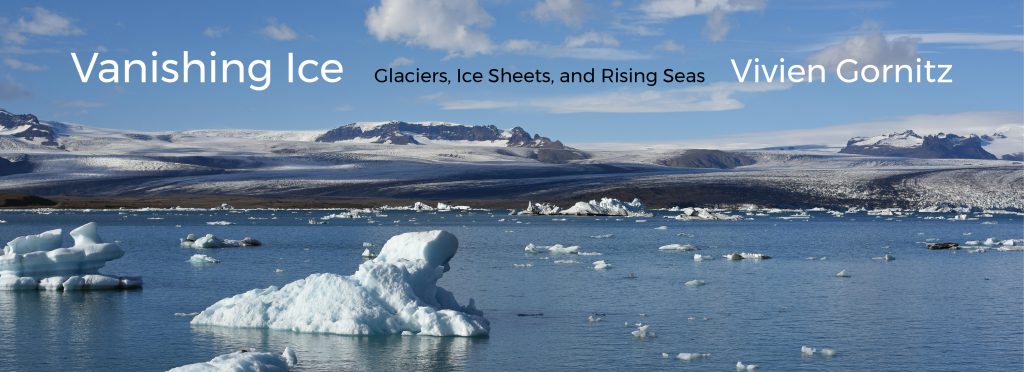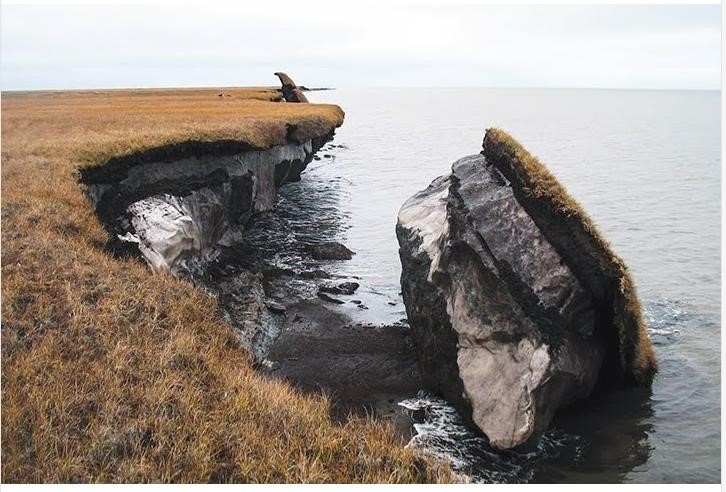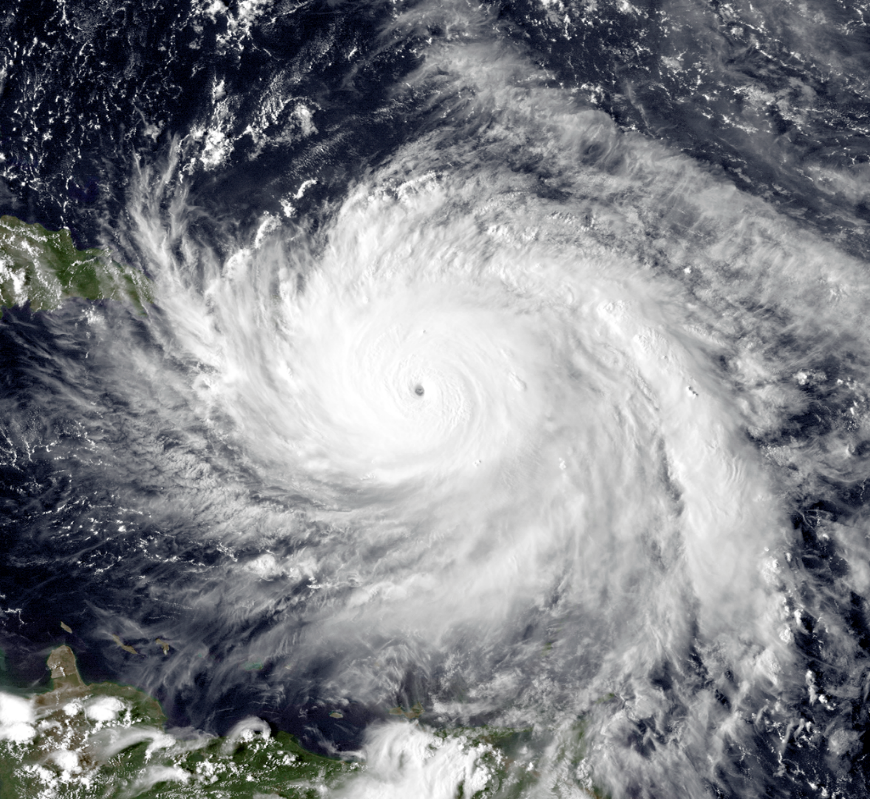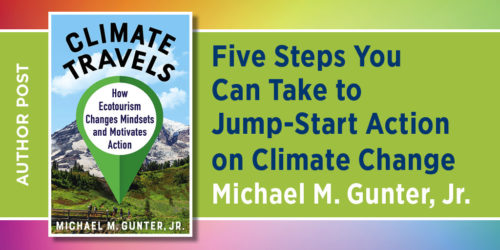Melting Glaciers and Ice Sheets: Why We Should Care About Our Vanishing Ice and Rising Seas

“Anyone who wants a better understanding of the different parts of the cryosphere, the consequences of melting ice, and this aspect of climate change will find this book an invaluable resource.”
~ Suzanne B. O’Connell, Professor of Earth and Environmental Sciences, Wesleyan University
It’s Earth Day! We’ve been featuring books about climate change and environmental studies throughout the month, but this week we’re specifically focusing on new and forthcoming titles that directly discuss the impact of human activity on global warming. This guest post by Vivien Gornitz, author of Vanishing Ice: Glaciers, Ice Sheets, and Rising Seas, discusses the current and future ramifications of our melting ice and snow.
Enter our Earth Day raffle for a chance to win a copy of Vanishing Ice!
• • • • • •
“People tend to focus on the here and now. The problem is that, once global warming is something that most people can feel in the course of their daily lives, it will be too late to prevent much larger, potentially catastrophic changes.”
~ Elizabeth Kolbert, The New Yorker, April 25, 2005.
Why should we care about vanishing ice and snow? Our planet is heating up—largely because human activities are injecting increasing amounts of greenhouse gases like carbon dioxide into the atmosphere. Climate change is no hoax. The last five years (2014-2018) have been the warmest in the modern record, as global temperatures continue to soar. In the Arctic, temperatures are rising twice as fast as in the rest of the world. Signs of this warm-up are becoming increasingly apparent, especially near the poles and on high mountains. More rain now falls on Greenland, even in winter in some places! The wetter weather is speeding up the melting of the ice sheet. Summertime meltwater pools are growing in number and size (Fig. 1).

The sharp drop in Arctic summer sea ice since the 1980s is another conspicuous manifestation of the changing cryosphere—the world of ice (Fig. 2). A once-perilous journey through the fearsome ice-laden Northwest Passage has lately turned into a leisurely summer cruise through open waters for a growing number of large commercial and tour ships. The giant luxury cruise ship, the Crystal Serenity, carrying over 1,000 passengers with a crew of nearly 600 repeated its record-breaking 2016 voyage through the Northwest Passage for a second time in August, 2017.

Vanishing Ice: Glaciers, Ice Sheets and Rising Seas vividly describes how the warming is already affecting people and the environment. Arctic peoples notice changes in the behavior of polar bears, seals, walruses, and reindeer, which in turn affects their hunting and herding lifestyles. As Sheila Watt-Cloutier, an Inuit spokeswoman, so poignantly expressed it: “As our hunting culture is based on the cold, being frozen with lots of snow and ice, we thrive on it. We are in essence fighting for our right to be cold.”
Trees tilt at weird angles like drunken sailors as permafrost thaws. Highways buckle and buildings sag and collapse, hampering construction, transportation, and development. Lakes suddenly appear and disappear in the permafrost, coastal cliffs crumble, and wave-battered shorelines wash away, as the changing climate transforms the regional ecology, hydrology, and landscape (Fig. 3). On the positive side, increasingly navigable northern waters will shorten shipping routes considerably, cut costs, and open up the Arctic for development of its potentially vast oil and mineral wealth, much of which lies in the Russian Arctic. However, development of as yet untapped mineral wealth exposes fragile tundra and wildlife to novel stresses from which recovery may be slow and difficult.

The Arctic is a major crucible of climate change. But these changes reverberate far beyond the deep north and other currently frozen realms. What does the thawing cryosphere portend beyond these already affected regions? As succinctly stated by a former NOAA administrator, Jane Lubchenko in 2012, “What happens in the Arctic doesn’t stay in the Arctic. What happens there often affects people around the world.” Therefore the big meltdown truly matters to all!
Even the sleeping giant southern gorilla, Antarctica, stirs and begins to flex its muscles, with potentially dire future consequences for distant lands. Ice shelves surrounding much of Antarctica, and some high Arctic islands, that normally hold ice sheets and maritime glaciers in check have begun to thin and weaken. At least ten large fringing ice shelves on the Antarctic Peninsula have crumbled one by one, like a pile of dominoes, since the 1990s (Fig. 4). Glaciers feeding into the ice shelves then surged seaward. Could this foreshadow the fate of other ice shelves farther south? Many ice shelves fringing Antarctica have begun to thin, especially in the Amundsen Sea sector of West Antarctica. Even the massive ice sheet itself is not immune. For roughly the past twenty years, the Antarctic Ice Sheet has been losing more ice than it has gained.
These visible changes may be just the tip of the proverbial iceberg. As permafrost thaws, will greenhouse gases like methane or carbon dioxide bubbling up from soggy, unfrozen Arctic soils and the seabed reinforce the ongoing warming trend? Which of these two greenhouse gases matter more to the permafrost climate feedback? Will Arctic vegetation grow wetter or drier? These questions grip scientists in a heated debate, as reviewed in the book.
Several feedbacks reinforce the unprecedented late 20th—early 21st century rise in Arctic temperatures and speed up ice losses. For example, less summer sea ice leads to more open ocean water. This sets up an ice-albedo feedback, in which nearly ice-free broad expanses of open water reflect less sunlight, and instead, absorb more of the sun’s heat. Consequently, more sea ice melts, enabling escape of more heat and moisture into the atmosphere. A warmer atmosphere, in turn, causes even more sea ice to melt.
Most high mountain glaciers around the world are in retreat, as are many that reach the sea (Fig. 5). A new study, released just a few days ago, reveals that glaciers lost enough ice since 1961 to raise global sea level by 27 millimeters. Within the last decade, losses have increased to nearly 1 millimeter per year, close to a third of the global total sea level rise. Darkening peaks not only impact wintertime sports, and classic mountain scenery, but also diminish the reliability of water supplies further downstream. Warming of the mountains and the worldwide retreat of glaciers begin to alter the timing and magnitude of peak spring snowmelt runoff. Too early a seasonal snowmelt may lessen water supplies to urban centers and farmlands when most needed later in the summer growing season. Mountain regions, including the Andes, the Himalayas, and several western U.S. states, dependent to a certain extent on glacier snowmelt, would face mounting water and food insecurity. And as the glaciers dwindle, and alpine permafrost thaws, the high mountains become unglued, increasing the hazards of landslides, avalanches, and glacial outburst floods driven by swollen spring river flows.
Melting glaciers and ice sheets contribute increasingly to global to sea level rise, which impacts tens of millions of people living in coastal areas around the world. Sea level rise represents the other side of the same coin as thawing ice sheets and glaciers. These two sides of the coin have been closely interwoven throughout most of geologic history, as initially outlined in Rising Seas: Past, Present, and Future, and explored at greater length in Vanishing Ice: Glaciers, Ice Sheets and Rising Seas. This close relationship continues today and will likely strengthen in the future.
The worldwide menace of sea level rise looms over the tens of millions of people who live along the world’s shorelines and who face an ever-growing vulnerability to coastal storm floods, made worse by rising sea levels. Ice sheet losses, along with diminishing glaciers, already account for nearly two-thirds the observed sea level trend of roughly 3 millimeters per year since 1993, and this share is likely to grow in the future. The vast stores of ice on Greenland and Antarctica would raise sea level by 66 meters (217 feet), if fully melted. The two still-frozen giants hold momentous keys to our future well-being. While a large-scale destabilization of the polar ice sheets appears quite unlikely within the next century or two, neither can it be ruled out completely, nor can even greater degrees of melting be discounted still further into the future, if carbon emissions continue to rise. Thus it becomes critical for us to gain a clearer understanding of the future behavior of the ice sheets. Vanishing Ice describes the current state of the cryosphere, and offers plausible scenarios of how much and how fast ice may melt in the future, by what means, and with what consequences.
A unique feature of the book is the long-term perspective obtained by carefully examining the correlations between corresponding changes in the cryosphere and sea level variations over the past few million years. The history of expansion and contraction of the Greenland and Antarctic ice sheets holds valuable clues to the future stability of these vast icy storehouses. In addition to geophysical and geochemical records of past climates are new observations and modeling studies probing the dynamic behavior of ice sheets, which will shed light on the critical questions of how much and how soon they will melt and their impacts on future generations.

The heavy rains, destructive winds, and high storm surges of three intense hurricanes that in close succession flooded much of southern Texas, devastated Caribbean islands, including Puerto Rico, swept across the Florida Keys and left most of Florida without power for days during August and September, 2017 (Fig. 6), starkly illustrate the present dangers faced by low-lying coastal areas. The vulnerability of the world’s shorelines to coastal storm floods will grow with rising sea level. Many of the world’s most populous cities line the coast and face serious inundation risks: New York City, Los Angeles, London, Tokyo, Shanghai, Hong Kong, Mumbai (Bombay), Bangkok, and Miami to name just a few. Some small island states, such as Tuvalu, Kiribati, and the Maldives already plan for eventual evacuation and relocation.
The planet’s warm-up may bring us to a new climate regime that could ultimately endanger the cryosphere. We are inching toward a climate regime resembling those of past warm geological periods, such as that of the Last Interglacial, ~125,000 years ago, when sea level stood 6 meters or more (≥20 feet) higher, or even like the mid-Pliocene, 3.6—3.4 million years ago, which had similar atmospheric carbon dioxide levels as today (i.e., ~ 400 parts per million), but as much as ~20 meters (~66 feet) higher sea level. Climate experts warn against a temperature rise over 2°C (3.6°F, labeled as a “dangerous anthropogenic interference with the climate system” (UNFCCC¸ 2010). But the long atmospheric lifetime of today’s increasing carbon dioxide emissions virtually insures a warmer planet, a smaller cryosphere, and higher oceans.
Vanishing Ice transcends dry technical literature or sensational media coverage. The book builds a strong case depicting the dramatic rapid transformation of the cryosphere and the mounting evidence of an expanding meltdown. The latest science-based facts paint a convincing picture. . Although the book avoids thorny policy issues or mitigation recommendations more thoroughly covered elsewhere, its straightforward, well-documented presentation will open your eyes to the serious environmental challenges ahead and enable you to make well-informed choices that will help avert disaster. Losing ice truly matters because its consequences reach far beyond the icy regions.










